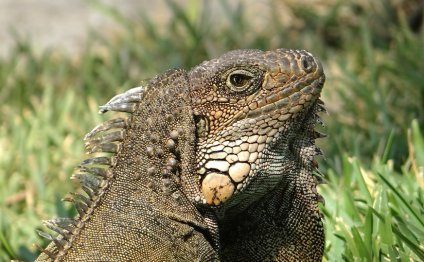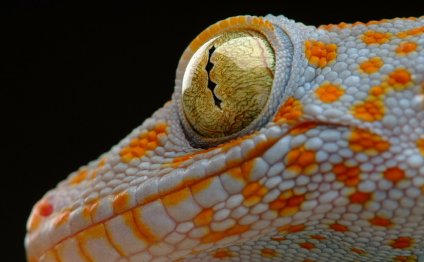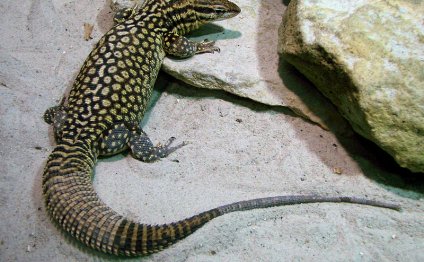
Herbivorous Lizards
Introduction
Totally herbivorous lizards are found in three disjunct regions: (1) the New World tropics northward into the Mojave Desert of the SW United States (all the Inguaninae but two species), (2) the Near the Middle East from North Africa to Southwest Asia (spiny tailed agamids Uromastyx); and (3) the tropical Far East in the Fiji Islands (the banded iguanas Brachylophus), the Philippines and Indonesia (water lizards Hydrosaurus) and the Solomon Islands (giant skinks Corusia). They are found on islands as well as continents, in predator-filled to nearly predator-free environments, in xeric (most), mesic, and hydric habitats, and they include both oviparous and viviparous (only Corusia) forms.
Perhaps the most unique characteristic of the lizards of the sub-family Iguaninae is their success at herbivorousness. Unfortunately, complete, reliable data on diet and feeding habits for most of the iguanines are not available; most of the published information is only anecdotal, and, in some cases (see below), clearly misleading. Intrigued by my own observations that the ground iguana, Cyclura carinata, is almost totally herbivorous from hatching through adulthood (a weight range of 15 to 1900 g), I began examining lizard herbivory in terms of diet, feeding habits, feeding strategies, and adaptational correlates (both morphological and physiological). By looking simultaneously at all of these aspects of herbivory, I hoped to better understand the mechanisms involved in its evolution in lizards.
Diet
For purposes of this discussion I consider as "truly herbivorous" (i.e., on the far right of the [carnivory-omnivory-herbivory] continuum) only those species whose diets include essentially only vegetation (whether fruit, flowers, seeds or foliage) throughout the year.
Many species generally called "herbivorous" are probably facultative herbivores at best, and more likely, simple omnivores. Based on the literature and my own dissections of several hundred lizard species, [most] such forms [species names omitted] although often termed herbivorous in the literature are clearly not true herbivores. In fact, by my definition, the only totally herbivorous extant lizards are the iguanines (+/- 30 species among the Iguanidae), the genera Uromastyx, Hydrosaurus among the Agamidae, and Corucia zebrata in the Scincidae.
I have also found no basis for earlier speculations that the iguanines Amblyrhynchus cristatus, Cyclura nubila, Iguana, and Dipsosaurus dorsalis, and the agamid Uromastyx hardwicki exhibit an ontogenetic shift from carnivory to herbivory [eating animal protein as juveniles, adopting an herbivorous diet as adult]. Most of these suggestions were based: (1) on diet information from captive lizards, or (2) on anecdotal field observations. In fact, of all the true herbivores I have dissected, only the iguanine Ctenosaura similis showed any indication of an omnivorous juvenile diet. Further field study will be necessary to establish quantitatively the extent of this omnivory by size and season (for C. similis). I thus conclude that an ontogenic shift from carnivory to herbivory is not usual in lizards truly herbivorous as adults, and further, that the documentation of such a transition (as appears to be the case for C. similis) will at best be the very rare exception rather than the rule.
Feeding Ecology
Other than Auffenberg's work, studies of the ecological aspects of feeding in herbivorous lizards have received little attention. However, it is known that herbivorous lizards spend the majority of their activity cycle resting, not feeding or foraging as do most carnivorous lizards or mammalian herbivores. Moberly estimated that Iguana spends 90% of its time resting, and Beverly Dugan estimated that the same species spent 96% of the day inactive and only 1% feeding.
Despite the apparent abundance of plant food, availability of food resources may be the primary limiting factor for populations of many iguanine lizards species. For example, in Columbia, Mueller has shown that green iguanas inhabiting strongly seasonal habitats are smaller than those in less seasonal habitats.
Rand has suggested that food may be limiting to Iguana iguana in highly seasonal tropical habitats...
RELATED VIDEO



Share this Post
Related posts
Colorful lizard
A very large species of chameleon that is endemic to forests in eastern and northern Madagascar. They reach up to 68 cm (27…
Read MoreFriendly pet snakes
Choosing a pet snake. A large part has to do with the person s personality along with how much space and time you have to…
Read More











